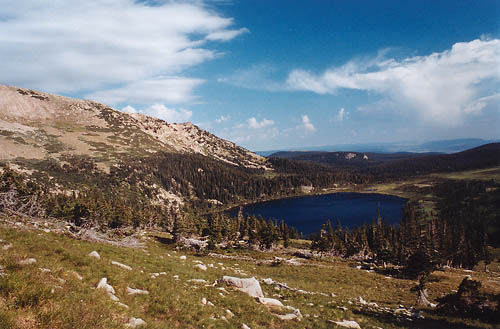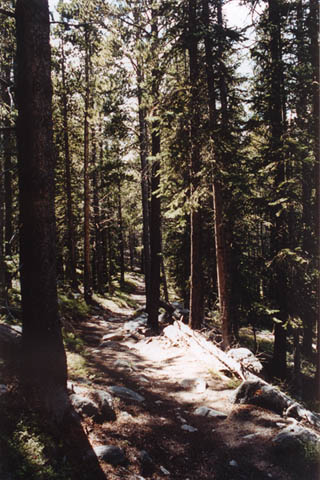 Location:
Rawah Wilderness, north-central Colorado. Location:
Rawah Wilderness, north-central Colorado.
Maps: USGS 7.5' Quad: Rawah Lakes; Trails Illustrated 1:40K: Cameron Pass #112 Access: From Ted's Place at the entrance to Poudre Canyon, drive about 53 miles west on HWY 14 to the Laramie River Rd, 2 miles west of the Big South TH. Go north for about 7 miles to the West Brach TH or another 4 to the Rawah TH. Fees: None Trails: Camp Lakes are 7.5 miles from either TH. Trailhead: NAD83 zone 13 426089e 4510707n Elev: 8400' Dog Regulations: Leash control Weather: Current and recent conditions from the NOAA (Oceanic AND Atmospheric...those guys are sharp!) Local Forecast from NWS July 2002 Smoke from fires burning at dozens of locations throughout the state had largely dissipated by the time Frank and I backpacked up to Camp Lakes on the last weekend of July 2002. It was the longest hike of the summer, about 7.5 miles, up to two alpine lakes nestled high in the Medicine Bow Range. We began our trip early in the morning, striking off in the brilliant glare of summer under a cloudless sky. I was a little nervous about the 10 other cars in the dirt lot near the trail head, but figured since this trail had many destinations, I would be alone most of the way. The trail provided the nicest hiking I did all summer. It started in boggy meadows and lowlands and rose up into dry sagebrush flats with plenty of wildflowers. From there, it quickly rose up into an open lodgepole pine forest with generous helpings of spring-green aspen towering overhead. I passed several small streams by way of wooden footbridges or flattened logs and before long I was laboring up a series of 10 switchbacks toward a ridge that would guarantee relatively level hiking from then on. I passed two groups of campers along the way, but my speed, combined with the steep-grade, started to cause a hot spot on my heel. I had to stop to apply moleskin for the only time all summer. The day was not hot, and the walking was pleasant. All around, a thousand shades of blue and green with occasional yellows and purples shone with clarity. Birds were singing and the soft breezes stirred the pines and caused the aspen leaves to twinkle like shimmering water in sunlight. I was soon strolling along deeply quiet dirt paths under a thick dark green 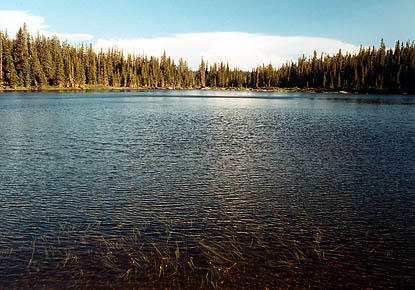 canopy
of spruce and fir, with an understory of bryophytes and mosses. The entire
trip up took about 4 hours. I reached Lower Camp Lake and hiked up the
steep wooded slope to the west and found a nice flat patch of ground surrounded
by spruces to pitch my tent. I left my pack by the tree and Frank and I
walked down to the lake to check it out. Frank trotted around to the south
end and I followed. The lake was shallow and had water plants growing up
along the shores. A small rivulet of crystal clear water ran into the lake
from the south. We continued around the north side of the lake where
the water became even shallower, and a small stream ran out of the lake
through a pile of large boulders. The delta of water out of the lake created
another marshy area covered thick as ants with yellow and purple flowers,
tall as my waist. canopy
of spruce and fir, with an understory of bryophytes and mosses. The entire
trip up took about 4 hours. I reached Lower Camp Lake and hiked up the
steep wooded slope to the west and found a nice flat patch of ground surrounded
by spruces to pitch my tent. I left my pack by the tree and Frank and I
walked down to the lake to check it out. Frank trotted around to the south
end and I followed. The lake was shallow and had water plants growing up
along the shores. A small rivulet of crystal clear water ran into the lake
from the south. We continued around the north side of the lake where
the water became even shallower, and a small stream ran out of the lake
through a pile of large boulders. The delta of water out of the lake created
another marshy area covered thick as ants with yellow and purple flowers,
tall as my waist.
We walked back to camp and I set up my tent and
hung my food. I was tired from the long hike so I decided to nap a little.
Frank and I slid into the tiny tent and dozed for an hour. I got up with
the intent to go fishing. I grabbed my rod and some snacks for my pocket
and set off. I tried for a bit at the first lake, but it was so shallow,
I wasnít surprised that I got nothing. So, I walked up to the upper lake,
½ mile away. The upper lake is about 5 times larger than the lower
lake, and has a dramatic glacial bowl behind it with jagged peaks. It was
cloudy when I got there, but calm. I fished for about 15 minutes before
the wind hit, making flycasting almost impossible, especially given the
thick alpine trees surrounding the lake. I never caught anything.
I decided I could at least walk around the lake and check it out, and maybe
fish if the wind died down. I bushwhacked a tough trail through very thick
vegetation, all taller than my head, around the west shore. I made it to
the south shore where water was seeping I dozed for a bit, and read for a bit, and it rained nonstop for hours. It was 8 in the evening when it finally cleared. We got out of the tent and ate a light meal, no cooking. I hung my clothes to dry in deep, perpetually dry, groves of spruce, and retreated to the tent after dark. I slept great and it never got colder than it had been when we went to bed.
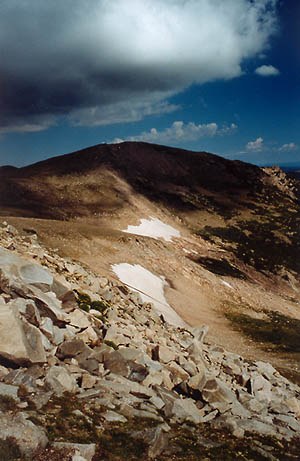 south
end of the upper lake and gained a vantage of the next valley over and
dozens of high peaks all around. The wind blew like mad, and I had to keep
my jacket on even though it was a rainjacket and didnít breath (and made
me sweaty). It took a lot of effort to scale the steep slope, but I made
it to the top and then was able to walk level to the west watching valleys
on both sides. It was very beautiful. I would have loved to go see more,
and someday I may go back to do it, but the black clouds rolling in told
me I better get the hell out of there. I was way above treeline, and lightening
would have a lot of trouble finding a better target than me on that ridge.
Thus, Frank and I scooted down quickly along the steep grassy slope and
walked around the edge of upper Camp Lake to get back to our camp. I found
upon returning that I was drenched with sweat from the rainpants and jacket,
so I had to hang those to dry. Fortunately, my normal clothes were nice
and dry. The rain materialized soon after, and Frank and I once again retreated
into the tent. Once again, there was no lightening. Hail came in small
quantities, and rain fell steadily for an hour. At 11, it stopped and I
had a nice lunch in the post-storm sunshine. I packed up camp and left
at 12. On the way back to the car, I went off the trail to the stream and
caught 6 brook trout. Many of them hit the fly almost before it hit the
water. It is very fun to catch fish that have never pondered the concept
of man before. One catch in particular was unusual. I snagged my line on
a stick held down by the current of a small spillway created by a downed
log in the stream. I managed to use the end of my rod to break loose the
stick from the sediment and current and pulled it towards me only to feel
the tug of a fish on the line! I was momentarily confused because I could
see my fly stuck in the stick, but south
end of the upper lake and gained a vantage of the next valley over and
dozens of high peaks all around. The wind blew like mad, and I had to keep
my jacket on even though it was a rainjacket and didnít breath (and made
me sweaty). It took a lot of effort to scale the steep slope, but I made
it to the top and then was able to walk level to the west watching valleys
on both sides. It was very beautiful. I would have loved to go see more,
and someday I may go back to do it, but the black clouds rolling in told
me I better get the hell out of there. I was way above treeline, and lightening
would have a lot of trouble finding a better target than me on that ridge.
Thus, Frank and I scooted down quickly along the steep grassy slope and
walked around the edge of upper Camp Lake to get back to our camp. I found
upon returning that I was drenched with sweat from the rainpants and jacket,
so I had to hang those to dry. Fortunately, my normal clothes were nice
and dry. The rain materialized soon after, and Frank and I once again retreated
into the tent. Once again, there was no lightening. Hail came in small
quantities, and rain fell steadily for an hour. At 11, it stopped and I
had a nice lunch in the post-storm sunshine. I packed up camp and left
at 12. On the way back to the car, I went off the trail to the stream and
caught 6 brook trout. Many of them hit the fly almost before it hit the
water. It is very fun to catch fish that have never pondered the concept
of man before. One catch in particular was unusual. I snagged my line on
a stick held down by the current of a small spillway created by a downed
log in the stream. I managed to use the end of my rod to break loose the
stick from the sediment and current and pulled it towards me only to feel
the tug of a fish on the line! I was momentarily confused because I could
see my fly stuck in the stick, but 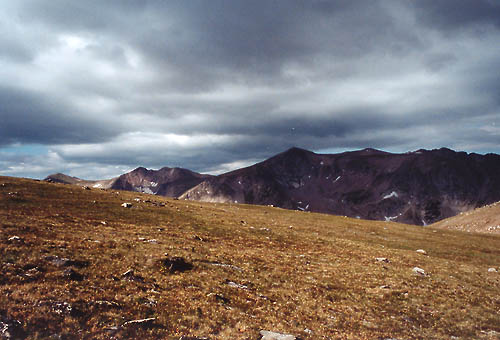 also
a monofilament glisten leading into the water toward a small trout. I pulled
the fish out and discovered a huge hook deep in its mouth tied to a line
stuck on the same stick I had snagged. There was no way to remove the giant
hook without killing the poor fish, so I cut the line at the eye of the
hook and put the little guy back in the pool, where he took off like a
black dart for the opposite bank. No telling how long heíd been tethered
to that stick, but I am sure glad I came along and let him loose. Iíve
heard fish can dissolve hooks rather quickly in their gullet. Hope thatís
true for that one. After that, fishing was over and Frank and I hiked down
the mountain, exploring numerous points of interest off the trail here
and
there. The hike down took a lot longer, of course, but was quite fun. My
feet took a beating, and the hot spots on my heels had become immense blisters.
I ended up losing both middle toenails, as seems to happen each year due
to major hikes. When I buy my next pair of boots, I'm adding two sizes
to my normal shoe size to give my toes more room on down-hill hikes. On
the drive back, I stopped at a small stream and fished a little more. I
caught nothing but was amused by the wily fish who stole for cover as soon
as they saw me on the bank. They HAD contemplated the concept of man before,
and had a good solution to his fishing methods. also
a monofilament glisten leading into the water toward a small trout. I pulled
the fish out and discovered a huge hook deep in its mouth tied to a line
stuck on the same stick I had snagged. There was no way to remove the giant
hook without killing the poor fish, so I cut the line at the eye of the
hook and put the little guy back in the pool, where he took off like a
black dart for the opposite bank. No telling how long heíd been tethered
to that stick, but I am sure glad I came along and let him loose. Iíve
heard fish can dissolve hooks rather quickly in their gullet. Hope thatís
true for that one. After that, fishing was over and Frank and I hiked down
the mountain, exploring numerous points of interest off the trail here
and
there. The hike down took a lot longer, of course, but was quite fun. My
feet took a beating, and the hot spots on my heels had become immense blisters.
I ended up losing both middle toenails, as seems to happen each year due
to major hikes. When I buy my next pair of boots, I'm adding two sizes
to my normal shoe size to give my toes more room on down-hill hikes. On
the drive back, I stopped at a small stream and fished a little more. I
caught nothing but was amused by the wily fish who stole for cover as soon
as they saw me on the bank. They HAD contemplated the concept of man before,
and had a good solution to his fishing methods.
|
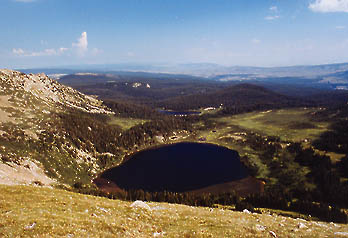 through
the ground to the lake from the snowfields on the cirque. This area was
very wet and marshy, and my boots sunk to the laces with each step. Contrary
to dying down, the wind had picked up, and I looked to the west to see
dark thunderclouds rolling over the top of the sharp ridge. Having flashbacks
to the time I got caught in the open in a thunderstorm at Twin Crater Lakes,
Frank and I started to sprint for the tent in the safety of the tall spruces.
We got soaked. Not so much from the rain, but from running through very
tall and very wet vegetation. We were both wet through and through upon
arrival to the tent. But it was well that we arrived when we did. While
it was only a shower while we were running, it was a downpour once inside
the tent. Even the taped seams of my tentís rainfly let water drip through
in places. I stripped off my wet clothes and hung them as best I could
in the vestibule of the tent. Then I tried to change into dry clothes and
get Frank wrapped up in a blanket to ease his shivering (it had turned
dastardly cold on us). It was during these attempted maneuvers when I discovered
that a tiny one-man backpacking tent is not meant for spending any time
but sleeptime within, especially with a dog. You canít move much, and even
simple things like putting on socks is difficult since you canít raise
your knees high enough to reach your feet without rubbing them along the
tent fabric which seems to sponge in water from the outside. The wind howled
outside and
through
the ground to the lake from the snowfields on the cirque. This area was
very wet and marshy, and my boots sunk to the laces with each step. Contrary
to dying down, the wind had picked up, and I looked to the west to see
dark thunderclouds rolling over the top of the sharp ridge. Having flashbacks
to the time I got caught in the open in a thunderstorm at Twin Crater Lakes,
Frank and I started to sprint for the tent in the safety of the tall spruces.
We got soaked. Not so much from the rain, but from running through very
tall and very wet vegetation. We were both wet through and through upon
arrival to the tent. But it was well that we arrived when we did. While
it was only a shower while we were running, it was a downpour once inside
the tent. Even the taped seams of my tentís rainfly let water drip through
in places. I stripped off my wet clothes and hung them as best I could
in the vestibule of the tent. Then I tried to change into dry clothes and
get Frank wrapped up in a blanket to ease his shivering (it had turned
dastardly cold on us). It was during these attempted maneuvers when I discovered
that a tiny one-man backpacking tent is not meant for spending any time
but sleeptime within, especially with a dog. You canít move much, and even
simple things like putting on socks is difficult since you canít raise
your knees high enough to reach your feet without rubbing them along the
tent fabric which seems to sponge in water from the outside. The wind howled
outside and 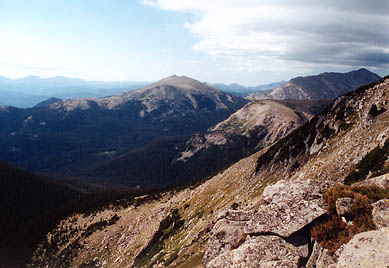 small
pebbles of hail came thumping down. I was thankful, however, that there
was no lightening associated with the storm. Frank was too, I'm sure. He
lay snug in his blanket, completely wrapped up and warm. I was snugly zipped
up in my sleeping bag with a knit cap over my head reading my book and
generally enjoying things. I worried that my only pair of dry pants might
not be dry by morning if the rain kept up, but figured Iíd have time in
the morning to sun dry them.
small
pebbles of hail came thumping down. I was thankful, however, that there
was no lightening associated with the storm. Frank was too, I'm sure. He
lay snug in his blanket, completely wrapped up and warm. I was snugly zipped
up in my sleeping bag with a knit cap over my head reading my book and
generally enjoying things. I worried that my only pair of dry pants might
not be dry by morning if the rain kept up, but figured Iíd have time in
the morning to sun dry them.
